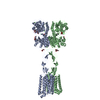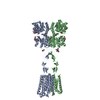[English] 日本語
 Yorodumi
Yorodumi- EMDB-45901: Focused refinement of the Heptahelical transmembrane (7TM) domain... -
+ Open data
Open data
- Basic information
Basic information
| Entry |  | |||||||||
|---|---|---|---|---|---|---|---|---|---|---|
| Title | Focused refinement of the Heptahelical transmembrane (7TM) domain of the calcium-sensing receptor bound to positive modulator '54149 | |||||||||
 Map data Map data | ||||||||||
 Sample Sample |
| |||||||||
 Keywords Keywords | G-protein coupled receptor / calcium-sensing / membrane protein | |||||||||
| Biological species |  Homo sapiens (human) Homo sapiens (human) | |||||||||
| Method | single particle reconstruction / cryo EM / Resolution: 3.5 Å | |||||||||
 Authors Authors | Wu C / Skiniotis G | |||||||||
| Funding support |  United States, 2 items United States, 2 items
| |||||||||
 Citation Citation |  Journal: Science / Year: 2024 Journal: Science / Year: 2024Title: Large library docking identifies positive allosteric modulators of the calcium-sensing receptor. Authors: Fangyu Liu / Cheng-Guo Wu / Chia-Ling Tu / Isabella Glenn / Justin Meyerowitz / Anat Levit Kaplan / Jiankun Lyu / Zhiqiang Cheng / Olga O Tarkhanova / Yurii S Moroz / John J Irwin / Wenhan ...Authors: Fangyu Liu / Cheng-Guo Wu / Chia-Ling Tu / Isabella Glenn / Justin Meyerowitz / Anat Levit Kaplan / Jiankun Lyu / Zhiqiang Cheng / Olga O Tarkhanova / Yurii S Moroz / John J Irwin / Wenhan Chang / Brian K Shoichet / Georgios Skiniotis /   Abstract: Positive allosteric modulator (PAM) drugs enhance the activation of the calcium-sensing receptor (CaSR) and suppress parathyroid hormone (PTH) secretion. Unfortunately, these hyperparathyroidism- ...Positive allosteric modulator (PAM) drugs enhance the activation of the calcium-sensing receptor (CaSR) and suppress parathyroid hormone (PTH) secretion. Unfortunately, these hyperparathyroidism-treating drugs can induce hypocalcemia and arrhythmias. Seeking improved modulators, we docked libraries of 2.7 million and 1.2 billion molecules against the CaSR structure. The billion-molecule docking found PAMs with a 2.7-fold higher hit rate than the million-molecule library, with hits up to 37-fold more potent. Structure-based optimization led to nanomolar leads. In ex vivo organ assays, one of these PAMs was 100-fold more potent than the standard of care, cinacalcet, and reduced serum PTH levels in mice without the hypocalcemia typical of CaSR drugs. As determined from cryo-electron microscopy structures, the PAMs identified here promote CaSR conformations that more closely resemble the activated state than those induced by the established drugs. | |||||||||
| History |
|
- Structure visualization
Structure visualization
| Supplemental images |
|---|
- Downloads & links
Downloads & links
-EMDB archive
| Map data |  emd_45901.map.gz emd_45901.map.gz | 483.1 MB |  EMDB map data format EMDB map data format | |
|---|---|---|---|---|
| Header (meta data) |  emd-45901-v30.xml emd-45901-v30.xml emd-45901.xml emd-45901.xml | 13.3 KB 13.3 KB | Display Display |  EMDB header EMDB header |
| Images |  emd_45901.png emd_45901.png | 81.1 KB | ||
| Filedesc metadata |  emd-45901.cif.gz emd-45901.cif.gz | 4 KB | ||
| Others |  emd_45901_half_map_1.map.gz emd_45901_half_map_1.map.gz emd_45901_half_map_2.map.gz emd_45901_half_map_2.map.gz | 474.7 MB 474.6 MB | ||
| Archive directory |  http://ftp.pdbj.org/pub/emdb/structures/EMD-45901 http://ftp.pdbj.org/pub/emdb/structures/EMD-45901 ftp://ftp.pdbj.org/pub/emdb/structures/EMD-45901 ftp://ftp.pdbj.org/pub/emdb/structures/EMD-45901 | HTTPS FTP |
-Validation report
| Summary document |  emd_45901_validation.pdf.gz emd_45901_validation.pdf.gz | 1.1 MB | Display |  EMDB validaton report EMDB validaton report |
|---|---|---|---|---|
| Full document |  emd_45901_full_validation.pdf.gz emd_45901_full_validation.pdf.gz | 1.1 MB | Display | |
| Data in XML |  emd_45901_validation.xml.gz emd_45901_validation.xml.gz | 17.8 KB | Display | |
| Data in CIF |  emd_45901_validation.cif.gz emd_45901_validation.cif.gz | 21.6 KB | Display | |
| Arichive directory |  https://ftp.pdbj.org/pub/emdb/validation_reports/EMD-45901 https://ftp.pdbj.org/pub/emdb/validation_reports/EMD-45901 ftp://ftp.pdbj.org/pub/emdb/validation_reports/EMD-45901 ftp://ftp.pdbj.org/pub/emdb/validation_reports/EMD-45901 | HTTPS FTP |
-Related structure data
- Links
Links
| EMDB pages |  EMDB (EBI/PDBe) / EMDB (EBI/PDBe) /  EMDataResource EMDataResource |
|---|
- Map
Map
| File |  Download / File: emd_45901.map.gz / Format: CCP4 / Size: 512 MB / Type: IMAGE STORED AS FLOATING POINT NUMBER (4 BYTES) Download / File: emd_45901.map.gz / Format: CCP4 / Size: 512 MB / Type: IMAGE STORED AS FLOATING POINT NUMBER (4 BYTES) | ||||||||||||||||||||||||||||||||||||
|---|---|---|---|---|---|---|---|---|---|---|---|---|---|---|---|---|---|---|---|---|---|---|---|---|---|---|---|---|---|---|---|---|---|---|---|---|---|
| Projections & slices | Image control
Images are generated by Spider. | ||||||||||||||||||||||||||||||||||||
| Voxel size | X=Y=Z: 0.75 Å | ||||||||||||||||||||||||||||||||||||
| Density |
| ||||||||||||||||||||||||||||||||||||
| Symmetry | Space group: 1 | ||||||||||||||||||||||||||||||||||||
| Details | EMDB XML:
|
-Supplemental data
-Half map: #2
| File | emd_45901_half_map_1.map | ||||||||||||
|---|---|---|---|---|---|---|---|---|---|---|---|---|---|
| Projections & Slices |
| ||||||||||||
| Density Histograms |
-Half map: #1
| File | emd_45901_half_map_2.map | ||||||||||||
|---|---|---|---|---|---|---|---|---|---|---|---|---|---|
| Projections & Slices |
| ||||||||||||
| Density Histograms |
- Sample components
Sample components
-Entire : Calcium-sensing receptor bound to compound '54149
| Entire | Name: Calcium-sensing receptor bound to compound '54149 |
|---|---|
| Components |
|
-Supramolecule #1: Calcium-sensing receptor bound to compound '54149
| Supramolecule | Name: Calcium-sensing receptor bound to compound '54149 / type: complex / ID: 1 / Parent: 0 / Macromolecule list: #1-#2 |
|---|---|
| Source (natural) | Organism:  Homo sapiens (human) Homo sapiens (human) |
-Experimental details
-Structure determination
| Method | cryo EM |
|---|---|
 Processing Processing | single particle reconstruction |
| Aggregation state | particle |
- Sample preparation
Sample preparation
| Buffer | pH: 7.5 |
|---|---|
| Vitrification | Cryogen name: ETHANE / Chamber humidity: 100 % / Chamber temperature: 277 K / Instrument: FEI VITROBOT MARK IV |
- Electron microscopy
Electron microscopy
| Microscope | FEI TITAN KRIOS |
|---|---|
| Image recording | Film or detector model: GATAN K3 (6k x 4k) / Average electron dose: 50.0 e/Å2 |
| Electron beam | Acceleration voltage: 300 kV / Electron source:  FIELD EMISSION GUN FIELD EMISSION GUN |
| Electron optics | Illumination mode: FLOOD BEAM / Imaging mode: BRIGHT FIELD / Nominal defocus max: 1.5 µm / Nominal defocus min: 0.5 µm |
| Experimental equipment |  Model: Titan Krios / Image courtesy: FEI Company |
- Image processing
Image processing
| Startup model | Type of model: PDB ENTRY PDB model - PDB ID: |
|---|---|
| Final reconstruction | Resolution.type: BY AUTHOR / Resolution: 3.5 Å / Resolution method: FSC 0.143 CUT-OFF / Number images used: 318351 |
| Initial angle assignment | Type: MAXIMUM LIKELIHOOD |
| Final angle assignment | Type: MAXIMUM LIKELIHOOD |
 Movie
Movie Controller
Controller












 Z (Sec.)
Z (Sec.) Y (Row.)
Y (Row.) X (Col.)
X (Col.)





































